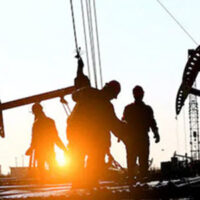Common Oilfield Hazards

Oilfield work is one of the most dangerous industries in the U.S., as workers are consistently exposed to toxic chemicals, heavy machinery, and dangerous equipment. Many also work long hours and must deal with bad weather conditions, including high winds, storms, freezing temperatures, and extreme heat. All of these things can lead to accidents and potentially catastrophic injuries.
Vehicle Collisions
According to the Occupational Health and Safety Administration, the fatality rate for employees who work in the oil and gas industry is seven times higher than most industries. Many of these fatalities were the result of vehicle collisions, as large trucks play a critical role in transporting equipment and workers to and from well sites, which are often located in remote areas. Accidents on the highway are also common. This is, in fact, the leading cause of fatal accidents among oil and gas extraction workers.
Struck-By Hazards
As many as three out of every five on-site oilfield fatalities are the result of a worker being struck-by, caught-between, or caught-in a hazard, like moving vehicles, high pressure lines, and falling equipment. Struck-by accidents occur when a part of the body is struck by an object in motion, whether falling, swinging, or flying. Many workers are injured in these instances when clearing a site, moving pipes, preparing pressurized lines, or loading equipment. Caught-in and caught-between accidents, on the other hand, occur when someone is pulled into machinery or equipment or gets caught, crushed, or pinned between objects that have fallen or rolled onto them.
Explosions/Fires
Explosions and fires are another very real hazard faced by oilfield workers, as much of their work involves exposure to flammable vapors and gases. These substances, including well gases, vapors, and hydrogen sulfide are all often released not only from wells, but also from trucks and production equipment, like tanks and shale shakers. Although stringent safety protocols are in place to prevent fires, ignition only requires something as simple as static, an electrical energy source, the use of cutting and welding tools, or frictional heat.
Falls
Many oilfield workers are required to work on platforms and equipment at great heights. Unfortunately, this means that they are at a much greater risk of fall hazards, such as:
- Uneven surfaces;
- Unprotected edges and sides;
- Open pits;
- Stairs;
- Ladders;
- Getting on and off mobile equipment;
- Working from truck beds; and
- Climbing and working from oil derricks.
Falls from drilling platforms and other elevated equipment can have devastating consequences, resulting in catastrophic injuries and even death.
Confined Spaces
Another hazard that is unique to oil workers is working in confined spaces, like petroleum storage tanks, mud pits, and excavated areas, all of which are common around wellheads. Working in these confined spaces comes with a risk of igniting flammable gases and vapors and inhaling hazardous chemicals.
Schedule a Complimentary Consultation with Our Legal Team
To speak with an experienced Tulsa oilfield accident lawyer about your recovery options after suffering an oilfield accident-related injury, call Levinson Law, P.C. at 918-492-4433.
Sources:
bls.gov/iif/oshcfoi1.htm
osha.gov/oil-and-gas-extraction/hazards
